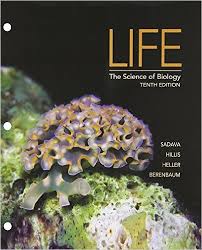Sadava 10th Edition Life The Science of Biology – Test Bank
Test Bank
to accompany
Life: The Science of Biology, Tenth Edition
Sadava • Hillis • Heller • Berenbaum
Chapter 4: Nucleic Acids and the Origin of Life
TEST FILE QUESTIONS
(By Grant Hurlburt)
Multiple Choice
1. Which of the following statements concerning genetic information in most cells is true?
a. The entire DNA molecule is copied to RNA during DNA replication.
b. A single DNA nucleotide codes for a single amino acid.
c. The flow of information in a cell is from DNA to RNA to protein.
d. The flow of information in a cell is from protein to RNA to DNA.
e. The flow of information in a cell is from DNA to protein to RNA.
Answer: c
Textbook Reference: 4.1 What Are the Chemical Structures and Functions of Nucleic Acids?
Bloom’s Category: 2. Understanding
2. A nucleotide contains a pentose sugar, a phosphate group, and a(n)
a. lipid.
b. acid.
c. nitrogen-containing base.
d. amino acid.
e. glycerol.
Answer: c
Textbook Reference: 4.1 What Are the Chemical Structures and Functions of Nucleic Acids?
Bloom’s Category: 1. Remembering
3. The difference between nucleosides and nucleotides is that
a. only nucleotides have nitrogenous bases.
b. a phosphate group is found in nucleotides but not in nucleosides.
c. nucleotides have the pentose sugar ribose; nucleosides have the pentose sugar deoxyribose.
d. in nucleosides the monomers are joined by phosphodiester bonds; in nucleotides the monomers are joined by hydrogen bonds.
e. nucleosides are the monomers of DNA; nucleotides are the monomers of RNA.
Answer: b
Textbook Reference: 4.1 What Are the Chemical Structures and Functions of Nucleic Acids?
Bloom’s Category: 2. Understanding
4. The bases of nucleic acids are purines or pyrimidines. Which of the following statements contrasting purines and pyrimidines is true?
a. Purines include the bases cytosine and thymine, whereas pyrimidines include the bases adenine and guanine.
b. Pyrimidines are found in RNA, whereas purines are found in DNA.
c. Purines are double-ring structures, whereas pyrimidines are single-ring structures.
d. Purines have only single bonds in their structure, whereas pyrimidines have both single and double bonds in their structure.
e. Purines consist of hydrogen, carbon, oxygen, and nitrogen, whereas pyrimidines have phosphorus, hydrogen, carbon, oxygen, and nitrogen.
Answer: c
Textbook Reference: 4.1 What Are the Chemical Structures and Functions of Nucleic Acids?
Bloom’s Category: 2. Understanding
5. Ribose and deoxyribose are both found in nucleic acids. The difference between ribose and deoxyribose is that
a. deoxyribose has one less oxygen atom.
b. ribose is a pentose sugar, whereas deoxyribose is a hexose sugar.
c. deoxyribose is found in DNA, whereas ribose is found in RNA.
d. Both a and b
e. Both a and c
Answer: e
Textbook Reference: 4.1 What Are the Chemical Structures and Functions of Nucleic Acids?
Bloom’s Category: 2. Understanding
6. What is attached to the 5ʹ-carbon of deoxyribose in DNA?
a. Adenine
b. Phosphate
c. Guanine
d. Thymine
e. Uracil
Answer: b
Textbook Reference: 4.1 What Are the Chemical Structures and Functions of Nucleic Acids?
Bloom’s Category: 2. Understanding
7. All of the following bases are found in DNA except
a. thymine.
b. adenine.
c. uracil.
d. guanine.
e. cytosine.
Answer: c
Textbook Reference: 4.1 What Are the Chemical Structures and Functions of Nucleic Acids?
Bloom’s Category: 1. Remembering
8. The four nitrogenous bases of RNA are abbreviated as
a. A, G, C, and T.
b. A, G, T, and N.
c. A, G, C, and U.
d. A, G, U, and T.
e. G, C, U, and N.
Answer: c
Textbook Reference: 4.1 What Are the Chemical Structures and Functions of Nucleic Acids?
Bloom’s Category: 1. Remembering
Related Test Bank














Reviews
There are no reviews yet.